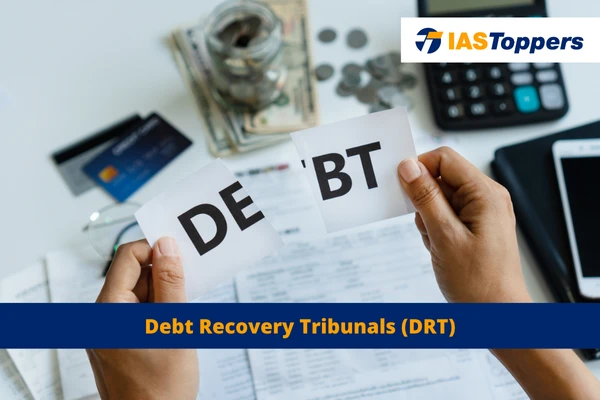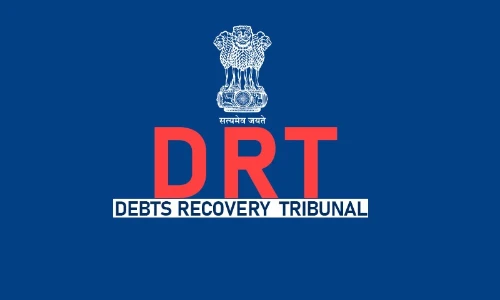Debt Recovery Tribunals, also known as DRTs, are semi-judicial bodies that were established under the Recovery of Debts due to Banks and Financial Institutions Act of 1993. These bodies assist banks and financial establishments in recovering their outstanding debts from borrowers. The importance of DRTs lies in their exclusive jurisdiction over debt recovery issues. They handle cases where the disputed loan amounts are above Rs 20 Lakhs, while cases involving smaller sums are delegated to civil courts. In this article, you will know about meaning and definition of Debt Recovery Tribunal, its origin, role, jurisdiction, procedure, appeal and issues. To explore more interesting UPSC Economy GS Paper – 3 topics like Debt Recovery Tribunals, check out other articles and IAS Notes of IASToppers.
Table of Content
- What are Debt Recovery Tribunals?
- History and origin of Debt Recovery Tribunals
- Role of Debt Recovery Tribunals
- Jurisdiction of Debt Recovery Tribunals
- Procedure of debt recovery tribunal
- Appeal against Debt Recovery Tribunal
- Recent issues related with DRTs
- Government efforts to rejuvenate DRT
- Conclusion
- FAQs on Debt Recovery Tribunals
What are Debt Recovery Tribunals?
- Debt Recovery Tribunals were established to facilitate the debt recovery involving banks and other financial institutions with their customers.
- Debt Recovery Tribunal is a quasi-judicial body set up under Recovery of Debts due to Banks and Financial Institutions Act (RDBBFI), 1993.
- DRTs can take cases from banks for disputed loans above Rs 20 Lakhs. Cases involving sums below this limit are presented in civil courts.
- DRT is controlled over by a Presiding Officer, who is qualified to be a District Judge and is appointed by notification by Central Government.
- The central Government may also authorize another presiding officer of a DRT other than discharging the function of a presiding officer of a DRT.
- The e-DRT project has been implemented in all DRTs to provides access to e-filing, e-payment of fees etc.
- At present, there are 39 Debts Recovery Tribunals (DRTs) and 5 Debts Recovery Appellate Tribunals (DRATs) at Mumbai, Delhi, Kolkata, Allahabad, and Chennai.
History and origin of Debt Recovery Tribunals
- Prior to DRTs, banks would file a case in civil court to recover dues from borrowers, a process that was governed by the Civil Procedure Code (CPC) of 1908. This procedure was slow and complex.
- T. Tiwari committee, set up in 1981, recommended to create quasi-judicial entities that would focus solely on debt recovery. However, the concept didn’t materialize.
- In 1991, the Narasimham Committee echoed the views of the Tiwari Committee, recommending the creation of Special Tribunals.
- This led to the introduction of the Recovery of Debts Due to Banks and Financial Institutions Act (RDDBFI), in 1993.
- The Act resulted in the formation of Debt Recovery Tribunals (DRTs) and Debt Recovery Appellate Tribunals (DRATs).
- The first-ever DRT was set up in Kolkata on April 27th, 1994.
Role of Debt Recovery Tribunals
- Debt Recovery Tribunals (DRTs) mainly aim to facilitate financial institutions and banks in their effort to recover outstanding loans from borrowers.
- Its authority is limited to hearing and settling cases involving recovery of loans that are declared Non-Performing Assets (NPAs) by banks under the guidelines of Reserve Bank of India.
- It also has a Recovery Officer who assists in enforcing the recovery certificates issued by the Presiding Officers.
Jurisdiction of Debt Recovery Tribunals
- Under Section 17 of the RDDBFI Act, the DRT is entrusted with the task of handling applications submitted by banks and financial institutions seeking to recover debts owed to them.
- Section 18 of the same Act limits other Courts’ jurisdiction over debt recovery issues. Under Articles 226 and 227 of the Constitution, only Supreme Court and High Courts can do adjudication of matters relating to debt recovery.
- Thus, any appeal against a verdict by the Debt Recovery Appellate Tribunal (DRAT) can only be sought through the High Court or the Supreme Court.
Procedure of debt recovery tribunal
Mainly, there are two ways to file application in DRT.
Direct Application Method:
- Here, the bank or financial institution can present an application to the DRT.
- This process is defined in the Recovery of Debts Due to Banks and Financial Institutions Act.
- The relevant form must be submitted to the DRT in the jurisdiction where the defaulting party lives or runs a business.
- Under this, the DRT must expedite the case within 180 business days.
SARFAESI Method:
- The SARFAESI or Securitisation and Reconstruction for Enforcement of Security Interest Act of 2002, applies to secured loans and credit.
- Secured loan is a loan in which a borrower pledges an asset (property, car etc.) or security against that loan.
- The risk of default is lower with secured loans, as the borrower has provided collateral. In case of default, the creditor can seize the collateral to recover the debt.
- However, if the collateral doesn’t fully cover the debt and the gap is significant, the creditor can approach the DRT under this act’s guidelines.
- The case needs to be fast-tracked within 60 to 120 days.
After Application Process:
- DRT has the authority to issue a provisional order against the debtor to prevent them from selling any of their assets.
- DRT may also hold the debtor in custody for 3 months if they show improper behavior.
- Following the application submission, a legal notice is sent to the defendant. The defendant can also counter-sue the bank or finance institution.
- After case closure, the presiding officer issues a certificate to the debt recovery officer, including details of the debt that can be liquidated to repay the outstanding amount.
Appeal against Debt Recovery Tribunal
- Appeals against orders passed by DRTs lie before Debts Recovery Appellate Tribunal (DRAT).
- Debts Recovery Appellate Tribunal are headed by a chairperson whose post is equivalent to a High Court Judge.
- The party has to appeal to DRAT within 30 days of the DRT’s order issuance. Extension can be made if DRAT is convinced there was a legitimate reason for delay.
Recent issues related with DRTs
- Slow process of resolution (settling debts and finding end to defaults).
- Less number of DRTs across India
- Delay in settling the cases is long.
- DRTs were not able to handle cases related to large borrowers.
- Timely appointment of officials for DRT has not been made.
Government efforts to rejuvenate DRT
i. Amendment to the RDBBFI Act 1993 in 2016:
- Introduces deadlines for each stage of the decision-making process within the DBT.
- Extends the retirement age of DRT Presiding Officers from 62 to 65, and Appellate Tribunal Chairpersons from 65 to 67.
- Additionally, Presiding Officers and Chairpersons now have the potential to be reappointed to their roles.
- Permits banks to present their cases in DRTs that hold jurisdiction over the bank branch where the debt is outstanding, instead of the DRT overseeing the debtor’s place of residence or business.
ii. The Insolvency and Bankruptcy Code enables DRTs to assess bankruptcy cases related to individuals and partnerships with unlimited liability.
Conclusion
DRTs have greatly streamlined the debt recovery process in India, providing a specialized platform for addressing such issues. Despite some challenges such as delayed resolutions and a limited number of DRTs, the Indian government has undertaken commendable steps to enhance the functionality of these tribunals. For a brighter future, further improvements in the system can be implemented, such as accelerating the appointment of officials and increasing the number of DRTs across the country.
Ref: Source-1
FAQs (Frequently Asked Questions)
What is debt recovery tribunal?
A Debt Recovery Tribunal, or DRT, is a semi-judicial body established under the 1993 Recovery of Debts Due to Banks and Financial Institutions Act. Its primary function is to aid banks and financial institutions in recovering their outstanding debts from customers.
What is the role and jurisdiction of Debt Recovery Tribunals in India?
Debt Recovery Tribunals (DRTs) in India are established to facilitate banks and financial institutions in recovering their due debts. They handle cases involving disputed loans above Rs 20 Lakhs. The jurisdiction of DRTs extends to handling applications by banks and financial institutionsfor debt recovery and their decision is appealable only at the High Court or Supreme Court.
What steps has the Indian government taken to improve Debt Recovery Tribunals?
The Indian government has revised the RDBBFI Act 1993, set adjudication timelines, extended retirement ages for officials, and broadened jurisdiction rules for filing cases, all aimed at enhancing the effectiveness of Debt Recovery Tribunals.



